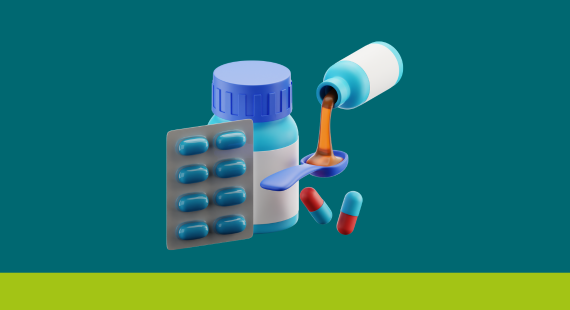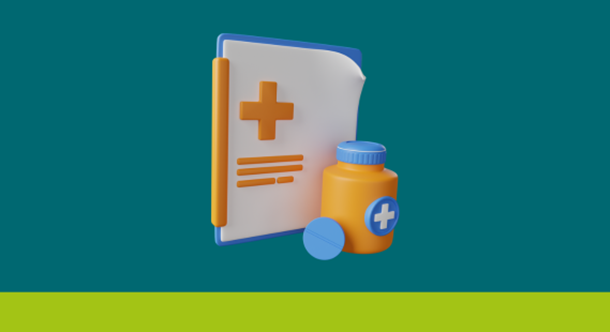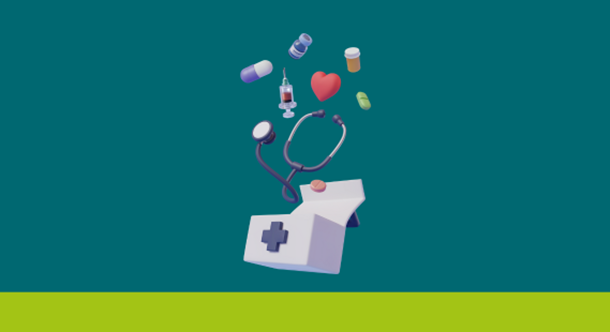
There are different medicines available to help with mental health difficulties; knowing what to expect can help maximise their benefits.
Ciara Ni Dhubhlaing, Chief Pharmacist here in St Patrick's Mental Health Services, shares overviews of some of the main types of medication which can be used in the treatment of mental health. She outlines what the different medicines aim to do, what forms they tend to come in, and what some of the common side-effects might be.
If you are considering starting medication or taking a medicine, having information can help you to get the most out of it and ensure you are taking it safely.
Please talk to your pharmacist, doctor, or nurse if you have any questions or concerns about medication.
Different types of medication
Anti-depressants
Anti-depressant medication is commonly prescribed for people with depression or low mood.
Some common types of anti-depressants include:
- Noradrenergic and specific serotonergic antidepressants (NaSSAs), like Mirtazapine
- Serotonin and norepinephrine reuptake inhibitors (SNRIs), such as Duloxetine and Venlafaxine
- Selective serotonin reuptake inhibitors (SSRIs), such as Escitalopram, Fluoxetine, Sertraline, and Vortioxetine.
These mainly target serotonin, noradrenaline, or dopamine, which are chemicals in our brains and bodies. Serotonin is linked with mood; noradrenaline has been linked with anxiety; and dopamine is related to our reward system (our ability to feel joy).
Most SSRIs, SNRIs and NaSSAs are available as tablets or capsules. Some are available as liquids or dispersible tablets which dissolve on the tongue, which can be useful if someone has difficulties with swallowing. Of these, some are easily available, while others might need to be made up specially. These groups of antidepressants are all relatively low risk in terms of overdose.
SSRIs, SNRIs and NaSSAs generally take about two to four weeks to work. For younger people, such as teenagers or young adults, changes can begin within one to two weeks. For older adults, it can take longer, at up to six to eight weeks, for an effect to be felt.
Common side effects of SSRIs, SNRIs and NaSSAs include:
- Nausea in the early stages of taking the medication, due to changes in serotonin in our stomachs as well as our brains
- Agitation, especially in younger people – thoughts of self-harm or suicide can sometimes occur early in treatment or with dose changes; tell your team immediately if you notice this.
- Insomnia, which is why most are taken in the morning
- Sexual dysfunction, especially for SSRIs and SNRIs
- Sedation, particularly for NaSSAs
- Increased appetite, especially with NaSSAs.
There are some other, older forms of anti-depressants, which include:
- Monoamine oxidase inhibitors (MAOIs), such as Moclobemide, Phenelzine, and Tranylcypromine
- Tricyclic antidepressants (TCAs), such as Amitriptyline, Nortriptyline, Clomipramine, Dosulepin, and Trazodone.
TCAs and MAOIs are mainly available as tablets, with some coming in liquid form. Again, these target serotonin and noradrenaline, and they take about two to four weeks to have an effect, or perhaps a bit longer for older people.
Common side effects with TCAs and MAOIs include:
- Dry mouth
- Constipation
- Urinary retention, or difficulty urinating
- Sedation (a state of calm or sleepiness).
At higher doses, they can cause cardiac effects (effects on the heart). This means they can have a higher risk of overdose, so there is close care paid to dosages of these medicines used, how the person takes them, and whether it is best suited for the person to be taking them.
MAOIs can also interact with certain foods so a special diet may be required.
Antipsychotics
Anti-psychotic medication may be prescribed for people with experiences of psychosis.
Anti-psychotics are spoken about in terms of being “first generation” or “second generation”.
First generation anti-psychotics are an older group of medicines, and include, for example, Haloperidol, Chlorpromazine, Sulpiride and Zuclopenthixol. These tend to have a broader range of side-effects, as they came about at a time when we didn’t have the same skills or knowledge around developing medication.
Second generation anti-psychotics are newer and include Risperidone, Olanzapine, Paliperidone, Amisulpride, Clozapine, and Aripiprazole. While these have fewer side effects than the older anti-psychotic medications, they can still have significant side effects as well.
Some of these medicines are available as tablets or dispersible tablets; some come as liquids; and an advantage for some people is that many are available as injections. Injections are often monthly or may be up to once every three months and can be helpful, for example, if someone does not like taking tablets or finds it difficult to remember to take tablets.
Anti-psychotic medication mainly targets dopamine and serotonin. In the case of dopamine, they work to dampen this hormone down, as, in psychosis, dopamine tends to be overactive in our brains. It generally takes four to six weeks for the medicines to have an effect. However, some people can notice changes earlier on, largely due to the sedative (calming or sleep-inducing) effects of the medicines; these can help with sleep, which, in turn, can improve symptoms overall.
Along with sedation, other common side effects include:
- Constipation
- Dry mouth
- Movement problems, such as stiffness or shakes, especially when the first-generation medicines are taken at high doses
- Increased appetite and weight gain, particularly with second generation medicines
- Sexual dysfunction
- Cardiac effects when the medication is taken at high doses.
Mood stabilisers
Mood stabilisers are a broad range of medicines which can help to reduce ‘mood swings’ (that is, extreme changes in mood which can be linked to mental health difficulties like bipolar disorder or other mood disorders).
They include:
- Carbamazepine (Tegretol)
- Lamotrigine (Lamictal)
- Lithium (Priadel)
- Sodium Valproate (Epilim).
Mood-stabilising medication comes in tablet or pill form, liquid form, and as dispersible tablets.
The targets of these medicines can vary. Many are anti-epileptics, which means they work to reduce overactivity of electrical impulses in the brain which can cause signs and symptoms of bipolar disorder or mania (as well as seizures that occur in epilepsy). Most take about two weeks to work, but some, such as Lithium, can take longer. Some need to be gradual dose increases and can therefore take longer to have a therapeutic effect.
Common side effects for mood stabilisers include:
- Sedation
- Increased appetite
- Weight gain
- Tremors or shakes
If weight gain becomes an issue– particularly if someone is taking other medicines which can affect weight – exercise and planning meals can be helpful. It is also possible to take other medicines which can help reduce weight gain, or to look at changing medication if needed.
Anxiolytics and hypnotics
An anxiolytic is an anti-anxiety medication. Hypnotics are sleeping tablets. Most of these are part of same family and can be easily recognised as their names tend to end with the letters “azepam” (when they are in the group known as “benzodiazepines”). Some are also known as “Z drugs”.
Examples include:
- Alprazolam
- Clonazepam
- Diazepam
- Flurazepam
- Lorazepam
- Temazepam
- Zolpidem.
Most anti-anxiety medicines and sleeping tablets are available in tablet or capsule form, with a small few available as liquids. They usually work quite quickly, usually within around 20 minutes to an hour. Some are also quite long-lasting; for instance, some can last overnight and leave the person with a ‘hangover effect’ the next day. This can mean having a headache or feeling groggy or drowsy, so it is very important to be careful the following day when engaging in activities like driving.
These medicines target gamma-aminobutyric acid (GABA). GABA is an amino acid in our brains which affects the ability of nerve cells to send or receive chemical messages in our central nervous systems. Changes in levels of GABA in our brains can be related to feelings of anxiety, stress and fear, or the reduction of these symptoms when taking medications that target GABA.
Pregabalin also works on GABA, though it is not part of the family of benzodiazepine medications or ‘z-drugs’.
Sedation is an effect of anti-anxiety medication and sleeping tablets, but one that is usually desirable. Other common side effects include:
- Dissociation (a feeling of being spaced out or separate from what’s going on)
- Reduced impulse control (difficulty controlling urges or actions)
- Dependence on the medication.
These medicines need to be used carefully. For example, the effect of dissociation can be useful for people experiencing anxiety, but, when people are taking anxiolytics or hypnotics, it’s important to find a balance so that this effect doesn’t go too far. Benzodiazepines and alcohol work in the same part of the brain. In the same way as after a few drinks of alcohol, benzodiazepines may reduce the person’s ability to think clearly or to make good decisions and can be addictive. For these reasons, these medicines need to be used well and not for too long – ideally for only a few days or weeks whilst symptoms are bad.
Anti-dementia medications
Anti-dementia medicines may be prescribed to help with symptoms of dementia and Alzheimer’s Disease.
Examples of anti-dementia medication include:
- Donepezil
- Galantamine
- Memantine.
These can be available as tablets, liquids, and patches. Patches can be particularly helpful for warding off some of the stomach problems, which can be a side effect of these medicines, as the drug goes straight to the bloodstream rather than through the stomach.
Donepezil, Galantamine and Rivastigmine are acetylcholine inhibitors, which mean they work to stop the breakdown of acetylcholine. Acetylcholine is a chemical in the brain which helps nerve cells to send messages to each other. Preventing its breakdown helps to stabilise symptoms of dementia. Memantine also aims to stabilise symptoms.
Common side effects can include:
- Gastric, or stomach, problems like nausea and diarrhoea
- Headache
- Dizziness
- Changes in heart rate, particularly drops in heart rate.
Attention Deficit Hyperactivity Disorder (ADHD) medications
ADHD is a type of neurological condition (a condition that affects the brain and nervous system) that can affect people’s behaviour. There are three main types of symptoms linked to ADHD: hyperactivity, impulsivity, and inattention.
ADHD medicines target dopamine and noradrenaline, and examples include:
- Atomoxetine
- Lisdexamphetamine
- Methylphenidate.
They usually take effect within a few hours, helping people to feel calmer and able to think a bit more clearly.
Some common side-effects of ADHD medication include:
- Insomnia
- Drowsiness
- Nausea or upset stomach
- Loss of appetite
- Delayed growth, particularly when the person is young
- Increased heart rate, when taken at higher doses.


